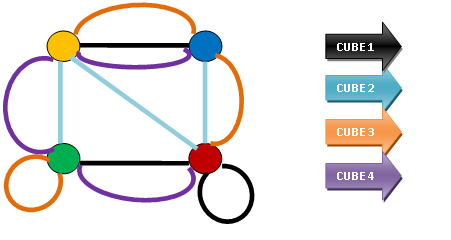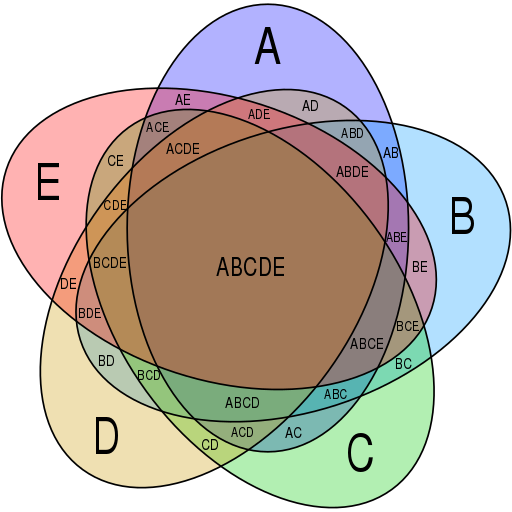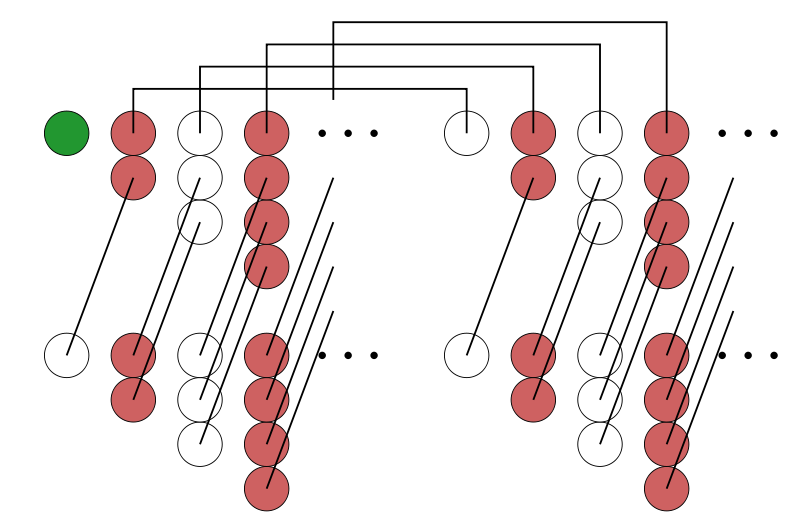286 = 77371252455336267181195264
That’s the largest known power of 2 with no zeros in its decimal representation.
Are there higher such powers? No one knows.
286 = 77371252455336267181195264
That’s the largest known power of 2 with no zeros in its decimal representation.
Are there higher such powers? No one knows.
Created by Franz Armbruster in 1967, “Instant Insanity” was the Rubik’s Cube of its day, a simple configuration task with a dismaying number of combinations. You’re given four cubes whose faces are colored red, blue, green, and yellow:

The task is to arrange them into a stack so that each of the four colors appears on each side of the stack. This is difficult to achieve by trial and error, as the cubes can be arranged in 41,472 ways, and only 8 of these give a valid solution.
One approach is to use graph theory — draw points of the four face colors and connect them to show which pairs of colors fall on opposite faces of each cube:

Then, using certain criteria (explained here), we can derive two directed subgraphs that describe the solution:

The first graph shows which colors appear on the front and back of each cube, the second which colors appear on the left and right. Each arrow represents one of the four cubes and the position of each of the two colors it indicates. So, for example, the black arrow at the top of the first graph indicates that the first cube will have yellow on the front face and blue on the rear.
This solution isn’t unique, of course — once you’ve compiled a winning stack you can rotate it or rearrange the order of the cubes without affecting its validity. B.L. Schwartz gives an alternative method, through inspection of a table, as well as tips for solving by trial and error using physical cubes, in “An Improved Solution to ‘Instant Insanity,'” Mathematics Magazine 43:1 (January 1970), 20-23.

The end of the Civil War opened a new era of fossil hunting in the American West — and a bitter feud between two rival paleontologists, who spent 20 years sabotaging one another in a constant struggle for supremacy. In this week’s episode of the Futility Closet podcast we’ll tell the story of the Bone Wars, the greatest scientific feud of the 19th century.
We’ll also sympathize with Scunthorpe and puzzle over why a driver can’t drive.

I just ran across this, offered by Morton C. Schwartz in an old issue of Pi Mu Episilon Journal:
Take any number of zeros and any number of ones and place them in a circle, in any order. Reproduce the circle a second time, concentrically with the first. Rotate either circle, and any number of places. The number of zeros opposite ones will always be even.
(Morton C. Schwartz, “An Amazing Parity Theorem,” Pi Mu Episilon Journal 5:7 [Fall 1972], 338.)
When logician John Venn introduced the famous diagrams that bear his name, he expressed an interest in “symmetrical figures … elegant in themselves.” He thought the “simplest and neatest figure” that showed all possible logical relations among four sets was four equal ellipses arranged like this:

“It is obvious that we thus get the sixteen compartments that we want, counting, as usual, the outside of them all as one compartment. … The desired condition that these sixteen alternatives shall be mutually exclusive and collectively exhaustive, so as to represent all the component elements yielded by the four terms taken positively and negatively, is of course secured.”
Interestingly, he added that “with five terms combined together ellipses fail us”: Venn believed that it was impossible to create a Venn diagram with five ellipses. Amazingly, that assertion went unchallenged for nearly a century — it was only in 1975 that Branko Grünbaum found a diagram with five ellipses:

It’s not possible to form a Venn diagram with six or more ellipses. Do we even need one with five? According to Reddit, yes, we do:
(Peter Hamburger and Raymond E. Pippert, “Venn Said It Couldn’t Be Done,” Mathematics Magazine 73:2 [April 2000], 105-110.)
A ring that encircles a length of chain will be caught in a loop if it tumbles during its fall. By Newton’s Third Law, when the turning ring strikes the chain it transfers momentum to the loop at the end — which causes it to rise and swallow the ring.
I just ran across this in an old Mathematical Gazette: R.H. Macmillan of Buckinghamshire shared a tidy expression for the area of a triangle whose vertices have coordinates (x1, y1), (x2, y2), and (x3, y3):
The sign is positive if the numbering is counterclockwise and negative if it’s clockwise.
“The expression is readily derived geometrically (using only the fact that the sum of the areas on each side of the diagonal of a rectangle must be equal) and so provides an interesting elementary exercise.”
(R.H. Macmillan, “Area of a Triangle,” Mathematical Gazette 77:478 (March 1993), 88.)

Darwin’s colleague Guillaume Duchenne first noticed the difference between smiles that are caused by enjoyment and those that aren’t. Both feature raised lip corners, but a genuine smile also activates the muscles around the eyes (lateral portions of the orbicularis oculi), causing “crow’s feet.”
This “Duchenne marker” is remarkably revealing. By observing it, researchers can predict whether an infant is being approached by its mother or by a stranger, and whether the infant’s mother is smiling at all. It also predicts when people who have lost their airline baggage began to feel less distress, how much a person enjoys being smiled at, whether a child has won or lost a game, and whether a person enjoys certain jokes and cartoons.
Beyond this, in clinical settings Duchenne smiles can predict a wide range of behaviors, including “whether a person will cope successfully with the death of his or her romantic partner; whether a person is an abusive caregiver; and whether a person is depressed, schizophrenic, recovering from an illness in general, or likely to respond successfully to psychotherapy.”
(From Mark G. Frank, “Thoughts, Feelings and Deception,” in Brooke Harrington, ed., Deception, 2009.)
In the early 1900s, blue tits and robins had easy access to cream from the tops of open milk bottles left on humans’ doorsteps. After World War I, the humans began to seal the bottle tops with aluminum foil. But remarkably, by the 1950s the entire blue tit population of the United Kingdom had learned pierce the foil to reach the cream, while the robins hadn’t.
The difference lay in cultural transmission: A blue tit can learn a new behavior by observing another bird performing it. Robins generally can’t do this — while an individual robin might learn to pierce the foil, it has no way to pass on this discovery to other robins. Young blue tits are reared in flocks in which they can observe one another, which is an advantage; robins are territorial and have fewer such opportunities.

Suppose s is the infinite series 1 – 2 + 3 – 4 + …. The diagram above presents 4 copies of the series. Each white disk represents +1, and each red disk represents -1. Each pair of red and white disks annihilates to zero, and the connecting lines show that all of the disks beyond the first +1 (green) can be paired off in this way. The result is that 4s = 1 and, perversely, that 1 – 2 + 3 – 4 + … = 1/4.
(It’s not really that simple — this series doesn’t tend toward any finite limit, but any summation method that’s linear and stable does produce the sum 1/4.)